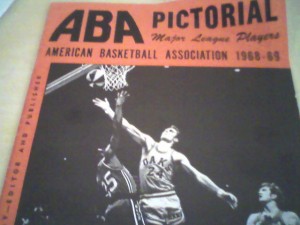Recently got my broken, bony fingers on a rare copy of ABA Pictorial 1968-69, from the old American Basketball Association. The upper-right-hand corner is a little crooked, but who isn’t in this day and age? The league’s most famous player of that year, Rick Barry of the Oakland Oaks, graces the cover. The periodical cost one buck at the time.
The booklet has some ads for sneakers that provided almost no support for ankles and arches. But it’s mostly filled with propaganda for the dirt-poor league, written by the ABA PR directors, who were trying to spread the gospel of high hopes for the Minnesota Pipers, New Orleans Buccaneers, Kentucky Colonels, etc. And the “ABA Outlook Extremely Bright” article leaves little room for argument against the league that would be defunct by 1976, with some of its teams folding into the NBA.
One interesting article written by announcer Terry Stembridge, titled “63 Feet To Spare,” recounts how Jerry Harkness of the Indiana Pacers sunk a buzzer beater from way downtown to defeat the Dallas Chaparrals. An excerpt:
“I had already called it a Chaparral victory that night in Dallas, a heartbeat before Jerry Harkness scored the longest shot in the history of basketball to give Indiana a 119-118 victory. It turned out to be the most premature journalistic announcement since that Chicago headline in 1948 proclaimed, “Dewey Defeats Truman.”
Since history never hands you the script for its most dramatic moments, no one in Memorial Auditorium thought there could be anything beyond what had just taken place for 47 minutes and 59 seconds between the Dallas Chaparrals and the Indiana Pacers. No one dreamed there could be another stroke of fortune beyond John Beasley’s field goal in the final two seconds to give Dallas a 118-116 lead and apparent victory.
When I saw Beasley’s shot bury itself in the cords, I shouted over the deafening roar that Dallas had won. Even as I spoke, I saw the clock and Jerry Harkness. I was surprised to see that a second remained but I knew it would make no difference. I watched Harkness, barely in bounds, drawing back to throw the ball. And then, suddenly, the red, white and blue ball was gone on its 88-foot journey into history.”
More Miscellaneous Media:
- Tom Seaver’s Baseball Is My Life. (1973)
- Hockey Digest (1973)
- World’s Fair Guide (1964)
- World’s Fair Guide (1939)
- Buffalo Braves Yearbook (1972-73)
- New York Nets Yearbook (1976-77)
- “Tom Dooley” sheet music.
Tags: Jerry Harkness, Rick Barry, Terry Stembridge
Subscribe to my free, monthly Substack newsletter, "Books I Read This Month." Some new titles, some older, some rare.
Categories
About
Afflictor.com is the website of Darren D’Addario. Except where otherwise noted, all writing is his copyrighted material. ©2009-18.


